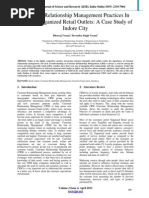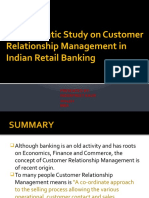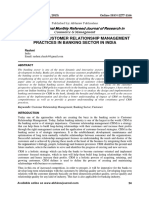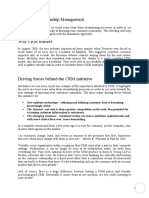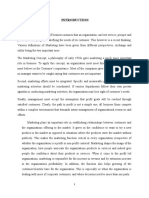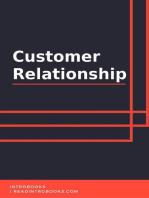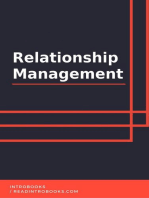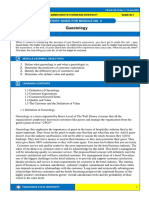Study of Customer Relationship Management (CRM) Practices in Organized Retail Shopping Malls at Bengaluru City in India
Study of Customer Relationship Management (CRM) Practices in Organized Retail Shopping Malls at Bengaluru City in India
Uploaded by
Gamers Squad TVCopyright:
Available Formats
Study of Customer Relationship Management (CRM) Practices in Organized Retail Shopping Malls at Bengaluru City in India
Study of Customer Relationship Management (CRM) Practices in Organized Retail Shopping Malls at Bengaluru City in India
Uploaded by
Gamers Squad TVOriginal Description:
Original Title
Copyright
Available Formats
Share this document
Did you find this document useful?
Is this content inappropriate?
Copyright:
Available Formats
Study of Customer Relationship Management (CRM) Practices in Organized Retail Shopping Malls at Bengaluru City in India
Study of Customer Relationship Management (CRM) Practices in Organized Retail Shopping Malls at Bengaluru City in India
Uploaded by
Gamers Squad TVCopyright:
Available Formats
Volume 2 ;Issue 2; March 2014 ; ISSN 2278 8425
Study of Customer Relationship Management (CRM) Practices in organized retail
shopping Malls at bengaluru city in India
Mayur Kumar.A*
*Assistant Professor,K.S.R.M college of Management studies, E-Mail-rohinimayur@gmail.com
Abstract
Retailing today occupies a key role in the world economy. It must be concisely and clearly
defined; retailing includes all the activities involved in selling goods or services directly to final
consumers for personal, non-business use. India retailing as seen in sprawling shopping center, multi-
stored malls and huge complexes offer shopping, entertainment and food all under one roof. In India
shopping malls are growing much more Shopping mall offers customers the possibility to be anything or
anybody they want to be, it gives them opportunity to be free and independent even if it’s just for a
passing moment. CRM is potentially a useful concept in the marketing and customer services areas of a
retail sector. CRM stands to be the survival mantra. Managing customer relationship effectively and
effectively boots customer satisfaction and retention rates. CRM involves shopping malls enabled
business processes that identify, develop, integrate and focus a business’ competencies on forging
valuable long-term relationships that deliver superior value to its customers. This study is undertaken to
identify the CRM practices on the customer satisfaction and retention in organized retail shopping malls
in Bangalore city India. The required data of study would be collected from both primary as well as
secondary sources. Liker scale was used in designing the questionnaire, A sample of 142 respondents was
taken from different malls located in bengaluru city has been selected for the reliability of the analysis.
The hypothesis has been tested by using ANOVA and Result of research as concluded the important to
enhance the CRM practices makes better to shopping at retail stores in shopping malls at Bangalore city.
Keywords: Retailing, organized retailing, Shopping Malls, Customer Relationship Management.
1. Introduction to Retailing in India: Customer Relationship Management
practices towards in Retailing:
Indian retail market is one & the
Indian’s fastest growing industries is expected to The highly demanding and
grow from us $ 350 billion to us $ 427 billion knowledgeable consumers are compelling
2010, retail is India’s largest industry accounting retailers to stock a huge product range, offer
for over 10 percent & the country’s GDP and attractive discounts in an aesthetically set up
around eight percent & employment. Retail in environment and soon all in the hope of having a
India is at the crossroads. It has paced industries loyal customer base so, customer relationship
with several players entering the market. management may be referred to as a philosophy
Retailing in India is gradually inching its way to a set of strategies, programmer and system
becoming the next boom industry. The whole which focuses on identifying and building
concept of shopping has altered in terms & loyalty with the retail outlet malls most valued
format and consumer buying behavior, ushering customers. This means that CRM will work on
in a revolution in shopping, modern retail has the principle that retailers have to chat out
entered India as seen in sprawling shopping programmes which will help them to raise their
centers, multi-storied malls and huge complexes profitability ones continuous basis though
offer shopping, entertainment and good all under building long-term relationship with their
one roof. In recent times, however more and customer’s customer Relationship management
more by retail outlets are coming up in the is a company business strategy designed to
metros and cities and the country. Many reduce cost and increase profitability by
business houses now thinking and opening up a solidifying customer loyalty. CRM practices
retail chain and their own, Spencer and co- may shift with each form. Nevertheless,
limited, Vitan industries limited pantaloon, organized retail shopping malls will benefit from
shoppers stop, Reliance malls, to name a few the resources it commits to developing its CRM
have already in the business with a big bang. practices in greater customer loyalty. Right time
International Journal on Global Business Management and Research
Volume 2 ;Issue 2; March 2014 ; ISSN 2278 8425
and involves attracting (acquiring),developing campaigns and concentration on existing
and maintaining successful customer customer. C. Bhattacharjee (2006) in his book
relationships over time and building customer “Services marketing concepts planning &
loyalty through efficient and effective two-way Implementation” Classified customer
dialogues that seek to understand and influence Relationship Management (CRM) have been
customer buying behaviors and improve undertaken to give all possible information to
customer acquisition, retention, loyalty and the current and potential customer. He says to
profitability Although not entirely built on achieve CRM, a company-wide set of tools,
shopping malls CRM involves shopping malls technologies, and procedures promote the
enabled business processes that identify, relationship with the customer to increase sales
develop, integrate and focus a business’ those CRM is primarily a strategic business and
competencies on forging valuable long-term process issue, rather than a technical issue. The
relationships that deliver superior value to its author concludes CRM is very hard to be
customers. implemented throughout a company. The IT
department needs extensive infrastructure and
2. Review of Literature resources to implement customer relationship
Darshan Desai, Sabrat Sahu and Piyush management (CRM) databases successfully.
Kumar Sinha (2007) on the basis of analytical
and empirical or case research conducted a Joseph. Nunes and Xavier Dreze (2006)
random sample study of 334 executives was in their article “Your loyalty program is
selected from 29 firms in the following betraying you” highlighted creating a successful
industries: retail (n=60), telecom (n=80) and loyalty program starts with defining what should
banking (n=183) in India. They also concluded be gained from the effort. In some cases, loyalty
that. Impact of market orientation on dynamic programs create what marketers call barriers to
capability of CRM and competitive CRM exit. They say that a benefit of loyalty programs
performance may be the result and shaping the that has gained prominence in the past decade is
organizational resources that no longer match their ability to provide useful data about
the environment. These include processes like customers. Sunjay Kumarkar and Alok kumar
analysis customers, developing and delivering Sahoo (2007) in his article define “Shopping
tailored offering, providing customer service, mall: Driving Force in organized Retailing”.
orchestrating linkages, assigning accountability Advocated mall is the latest format in the
and evaluating performance. Dr. N.K. Sehgal organized retailing, a significant development
(2007) classified customer relationship has occurred in last couple of year due to change
management as abbreviation about consumers, in consumer profile and spending behavior,
marketing effectiveness, sales and market trends. increasing youth population with more
He advocated the result of a business is a purchasing power and less time is looking for
satisfied customer “in present era of cutthroat shopping a long with entertainment as one stop
competition, it is no longer enough to satisfy the option. Roulac (1994) concluded from his study
customers. The reason for this is pretty simple”. that in shopping malls, consumers can shop
If you would not take care of your customers, without the problems of any traffic congestions
your competitors definitely would”. So the firm or parking problems, or security concerns.
should keep pleasing customers and they will
keep coming back. Vandana Ahuja (2008) Objectives of the Study
analyzed CRM build long terms profitable To identify the various categories of
relationships with chosen customers and getting Demographic factors and variables
closer to those customers with every point of impacting on CRM practices towards
contact with them. The author noted that a good organized shopping mall bengaluru city
CRM strategy aims at providing a win-win in India
platform for both the organization and the To study the impact of Demographic
customer by paying adequate information to the factors CRM practices towards
process of adoption by focusing on options organized shopping mall bengaluru city
available to customers’ adequate promotion in India
International Journal on Global Business Management and Research
Volume 2 ;Issue 2; March 2014 ; ISSN 2278 8425
CRM practices in shopping malls
Determinant
Consumer promotional tool
Gender Customer services at malls
Age
Activities of shopping Mall employees
Education
Income Data mining
Mall presentation
Loyalty programs
Customer satisfaction and retention
3. Research Methodology
In order to accomplish the objective of the sample of 150 But received 142 customers
study to collect data for this research study, both respondents of shopping mall in April 2013.
primary and secondary sources were used. The data was collected tying a survey and
Secondary data collected through the researcher- interpretation through to check the reliability of
reviewed articles related to research objective the data cronbach alpha test was applied in order
that appeared in the scholarly literature, key to find out the most preferable CRM practices
journals, reports, magazines and proceeding shopping malls view point Sample percentage
were systematically scanned for articles related method and one –way ANOVA analysis was
to the research topic. Primary data collected applied. All the analysis was carried out by
through an empirical investigation, online SPSS 16.0
survey was conducted, using a structure
questionnaire. RESEARCH HYPOTHESES
Present study consists and the H1: There will be significant variance in opinion
questionnaire two parts. Part-I questionnaire on CRM practices towards organized shopping
measures the distribution of participants on the mall among the Gender group
bases demographic characteristics and part-II
questionnaire measures CRM practices at H2: There will be significant variance in opinion
shopping mall on a five point scale ranging from on CRM practices towards organized shopping
(i) strongly disagree to (5) “strongly agree” mall among the Age group
Sample was collected on the basis of non-
probabilistic convenience sampling method. H3: There will be significant variance in opinion
The population in this study comprise of on CRM practices towards organized shopping
customer who loves shopping malls at mall among the Education
Bangalore. It is decided to choose in order to
collect the data a through online survey H4: There will be significant variance in opinion
structured questionnaire was farmed on CRM practices towards organized shopping
Questionnaires were distributed amongst the mall among the Income
International Journal on Global Business Management and Research
Volume 2 ;Issue 2; March 2014 ; ISSN 2278 8425
Table: 1 Demographic Representation of the respondents
Demographics Number of respondents Valid Percentage
A) Gender
Male 85 59.9
Female 57 40.1
B) Age
17-25 46 32.4
26-35 47 33.1
36-45 28 19.7
46-60 13 9.2
Above 60 8 5.6
C) Education
Undergraduate 15 10.6
Graduate 57 40.1
Postgraduate 70 49.3
D) Monthly Income
Less than 10000 8 5.6
10000 - 20000 36 25.4
20001 - 30000 41 28.9
30001 - 40000 23 16.2
40001 - 50000 20 14.1
142 100.0
Total
4. Analysis and interpretation –
Demographic Profile sample.
A total number 142 respondent participated in
the survey the demographic characteristics the Almost 49.3 percent were postgraduate,
respondent (Table1) shows that the sample 40.1percent post graduate are reported that
consisted, majority of respondents percent 59.9 education level play more significant dominant
of male and 40.1 percent female respectively. to give preferences and exportations shopping
The respondents were mostly between the age malls at Bangalore in India. Most of the
26-35 years age group with 33.1percent and in respondents belong to the income groups of Rs
the age group of 36-45 years 19.7 percent this (10,000- 20,000) 25.4 percent and (30001,-
shows the majority of the respondents were in 40000) 16.2 percent the sample mostly
the group of middle age persons shows much for represents the middle class income preferred to
more influencing to come for shopping malls at visits shopping
Bangalore.
International Journal on Global Business Management and Research
Volume 2 ;Issue 2; March 2014 ; ISSN 2278 8425
Table: 2
One –way ANOVA test for significant difference between gender on the variable of CRM practices
towards organized shopping mall
Sum of Mean
N Mean Squares df Square F Sig.
Consumer Between Groups
.066 1 .066 .190 .663
promotional 142
Within Groups 85 3.4882 48.475 139 .349
Total 56 3.4439 48.542 140
Customer Between Groups 142 3.4706 .093 1 .093 .219 .640
Services
Within Groups 85 3.5521 58.973 139 .424
Total 56 3.6046 59.066 140
Activities of Between Groups 142 3.5729 .364 1 .364 .831 .364
shopping
Mall Within Groups 85 3.4617 60.873 139 .438
employees Total
56 3.5655 61.237 140
Data mining Between Groups 142 3.5029 .293 1 .293 .380 .539
Within Groups 85 3.3221 107.203 139 .771
Total 56 3.4152 107.495 140
Mall Between Groups 142 3.3590 .006 1 .006 .012 .912
presentation
Within Groups 85 3.8422 70.007 139 .504
Total 56 3.8557 70.013 140
Loyalty Between Groups 142 3.8475 .038 1 .038 .078 .781
programs
Within Groups 85 3.6338 67.940 139 .489
Total 56 3.6674 67.978 140
Customer Between Groups 142 3.6472 .936 1 .936 1.830 .178
satisfaction
and Within Groups 85 3.8196 71.087 139 .511
retention Total
56 3.9861 72.023 140
From this ANOVA table 2 The Analysis of shopping Mall employees, Data mining, Mall
Variance test is applied to test for significant presentation, Loyalty programs, Customer
difference among the different gender for each satisfaction and retention–do not differ
influencing factor separately. The results of the significantly among the respondents of the
ANOVA are given in the above table. It is found different age groups. Hence, the null hypothesis
from the results of ANOVA that influencing with respect to all the six influencing factors is
CRM practices factors Consumer promotional accepted.
tool, Customer services at malls, Activities of
International Journal on Global Business Management and Research
Volume 2 ;Issue 2; March 2014 ; ISSN 2278 8425
Table: 3 One –way ANOVA test for significant difference age on the variable of CRM practices towards
organized shopping mall
Sum of Mean
Squares Df Square F Sig.
Consumer Between Groups .663 4 .166 .474 .755
promotional
Within Groups 47.913 137 .350
Total 48.575 141
Customer Between Groups 2.627 4 .657 1.587 .181
Services
Within Groups 56.688 137 .414
Total 59.316 141
Activities of Between Groups .816 4 .204 .461 .764
shopping
Within Groups 60.672 137 .443
Mall
Total
employees 61.488 141
Data mining Between Groups 3.261 4 .815 1.072 .373
Within Groups 104.234 137 .761
Total 107.496 141
Mall Between Groups .926 4 .232 .457 .767
presentation
Within Groups 69.441 137 .507
Total 70.368 141
Loyalty Between Groups 1.133 4 .283 .579 .678
programs
Within Groups 67.001 137 .489
Total 68.134 141
Customer Between Groups .205 4 .051 .098 .983
satisfaction
Within Groups 71.926 137 .525
and
Total
retention 72.132 141
From this ANOVA table 3 the Analysis of mining, Mall presentation, Loyalty programs,
Variance test is applied to test for significant Customer satisfaction and retention do not differ
difference among the different age groups for significantly among the respondents of the
each influencing CRM practices factor different age groups. Hence, the null hypothesis
separately. The results of the ANOVA are given with respect to all the six influencing factors is
in the above table. It is found from the results of accepted.
ANOVA that influencing factors Consumer
promotional tool, Customer services at malls,
Activities of shopping Mall employees, Data
International Journal on Global Business Management and Research
Volume 2 ;Issue 2; March 2014 ; ISSN 2278 8425
Table 4 One –way ANOVA test for significant difference education on the variable of CRM
practices towards organized shopping mall
Mean
Sum of Squares df Square F Sig.
Consumer Between Groups .214 2 .107 .308 .735
promotional Within Groups 48.361 139 .348
Total 48.575 141
Customer Between Groups .115 2 .058 .135 .874
Services Within Groups 59.201 139 .426
Total 59.316 141
Activities of Between Groups .097 2 .048 .110 .896
shopping Within Groups 61.391 139 .442
Mall Total
employees 61.488 141
Data mining Between Groups 6.319 2 3.160 4.341 .015
Within Groups 101.176 139 .728
Total 107.496 141
Mall Between Groups 2.656 2 1.328 2.726 .069
presentation Within Groups 67.712 139 .487
Total 70.368 141
Loyalty Between Groups .296 2 .148 .303 .739
programs Within Groups 67.838 139 .488
Total 68.134 141
Customer Between Groups 2.521 2 1.261 2.517 .084
satisfaction Within Groups 69.610 139 .501
and retention Total
72.132 141
From this ANOVA table 4, it is observed that Some factor data mining which is significant
the sig calculated are .735, .874, .896, .015.069, hence, the hypothesis formulated is accepted and
.739, .084 for all the influencing CRM practices it is inferred that there is no significant
factors which are greater than the significant (P difference among the different educational
> 0.05) and so it is not significant. qualification of the respondents on the
influencing CRM practices factors in shopping
malls in Bangalore city.
International Journal on Global Business Management and Research
Volume 2 ;Issue 2; March 2014 ; ISSN 2278 8425
Table 5 . One –way ANOVA test for significant difference Income on the variable of CRM practices
towards organized shopping mall
Sum of
Squares df Mean Square F Sig.
Consumer Between Groups 1.888 5 .378 1.100 .363
promotional Within Groups 46.688 136 .343
Total 48.575 141
Customer Between Groups 1.089 5 .218 .509 .769
Services Within Groups 58.226 136 .428
Total 59.316 141
Activities of Between Groups 2.822 5 .564 1.308 .264
shopping Mall Within Groups 58.666 136 .431
employees Total 61.488 141
Data mining Between Groups 3.429 5 .686 .896 .486
Within Groups 104.067 136 .765
Total 107.496 141
Mall Between Groups 3.515 5 .703 1.430 .217
presentation Within Groups 66.853 136 .492
Total 70.368 141
Loyalty Between Groups 3.351 5 .670 1.407 .226
programs Within Groups 64.783 136 .476
Total 68.134 141
Customer Between Groups 3.873 5 .775 1.543 .180
satisfaction and Within Groups 68.259 136 .502
retention Total
72.132 141
From this ANOVA table 5 , it is observed that factors which are greater than the significant (P
the sig calculated are for all the influencing .363, > 0.05) Hence, they are insignificant and so the
.769, .264, .486, .217, .226, .180,CRM practices above stated null hypothesis has been accepted
Table: 6
NO. Hypotheses Results Tools
H1 There will be significant variance in opinion on CRM practices reject ANOVA
towards organized shopping mall among the Gender group one way
H2 There will be significant variance in opinion on CRM practices reject ANOVA
towards organized shopping mall among the Age group one way
H3 There will be significant variance in opinion on CRM practices reject ANOVA
International Journal on Global Business Management and Research
Volume 2 ;Issue 2; March 2014 ; ISSN 2278 8425
Table: 6
towards organized shopping mall among the Education one way
H4 There will be significant variance in opinion on CRM practices reject ANOVA
towards organized shopping mall among the Education one way
5.Conclusion data mining: The art and science of
The CRM practices is important customer relationship management.
variables in the success of the shopping mall.. Industrial Management & Data Systems,
The study has identified the variables
influencing customer satisfaction. It can be 100(5), 245-246.
understood consumer promotional tool, Darshan,D. Sarbrat, S & Piyush,K.S(2007):
customer services at malls and high variance in “The role of Dynamic capability and
explaining towards services offered by mall information technology in customer
retailers at shopping mall at Bangalore. The relationship management: a study of
retailers should see in implementing the Indian companies” Vikalpa, Vol.32,
Activities of shopping mall employees and No.4, pp.45-60.
loyalty programs variables for enhanced Devesh, M, Madhurima, D., Kalyan Kumar &
satisfying to go for shopping to build a long- Gautam Sinha(2007): “Customer
term relationship with services provided by mall Relationship Management (CRM) in
retailer by customers. Shopping malls retailers context of food Marketing – A Fuzzy
should take in to consideration and Logic Approach” Indian journal of
understanding the customers touch points related Marketing .
to services offered by shopping malls. Even Diana l. H & Julie.B (2004): “it is all at the mall:
through the mall retailer were making adequate exploring adolescent girls experience”,
efforts there are some factors where the salient Journal of retailing vol-80, pp, 67-83.
or unsatisfied services levels are make clear and Gursharan,S.K & Joshi , D (2009): “The
improve some measures those levels to bridge perception of customers and Retailers
the gap to built long term relationship enhances towards malls in Jalandhar A
customers satisfaction and offers a pleasant supply chain perspective” Sinhgad
shopping experiences when the customers are business Review, Vol.1, Issue. 1, pp.61-
visiting shopping malls. Today “ customers is 68.
God “services offered by mall retailers play a Rintamaki, T. K. A. Kuusela, H.& Spence M.T,
major role in meeting customers’ expectations (2006): “decomposing the value of
and perception make comfortable better department store shopping into
shopping in malls. utilitarian, hedonic and social
dimensions – Evidence from Finland”,
References International Journal of Retail &
distribution Management 34 (1) pp 6 –
Baraklibai(2007): “ Short term thinking is 24.
getting in the way of the real issued: Keith A. R, & Eli Jones(2008): “Customer
what is the value of a customer and relationship management: Finding value
how can we enhance it?” Harvard drivers” Industrial Marketing
Business review south Asia, pp.30-31. management, vol. 37, 120–130.
Benjamin Appiah - Kubi & Andrews, K. D Kenyon, J., & Vakola, M. (2001). Evolving the
(2010): “Towards a successful customer customer relationship management
relationship management: A conceptual paradigm in the retail industry.
framework” African Journal of International Journal of Customer
Marketing Management ,Vol. 2(3) pp. Relationship Management, 3(4), 313-
037-043. 332.
Berry, M. A., & Linoff, G. S. (2000). Mastering
International Journal on Global Business Management and Research
Volume 2 ;Issue 2; March 2014 ; ISSN 2278 8425
Stan Maklan, & Simon. K (2009): “Dynamic
Capabilities: the missing link in CRM
investments” European Journal of
Marketing, Volume 43, Issue 11/12,
Pages 1392-1410.
Talpade. S & Hayes,J,( 1997 ): “Consumer
shopping behavior in malls with large
scale entertainment centers . Mid-
Atlantic”, Journal of Business 33 (2):
153 – 162.
Winer, R. S. (2001), A framework for customer
relationship management. California
Management Review, 43(4), 89-105.
International Journal on Global Business Management and Research
Volume 2 ;Issue 2; March 2014 ; ISSN 2278 8425
International Journal on Global Business Management and Research
You might also like
- HBR's 10 Must Reads on Strategic Marketing (with featured article "Marketing Myopia," by Theodore Levitt)From EverandHBR's 10 Must Reads on Strategic Marketing (with featured article "Marketing Myopia," by Theodore Levitt)4/5 (11)
- Customer Relationship Management in Hotel IndustryNo ratings yetCustomer Relationship Management in Hotel Industry66 pages
- Customer Relationship Management in Hotel Industry94% (33)Customer Relationship Management in Hotel Industry66 pages
- A Study On Customer Satisfaction at Orient Technology Pvt. Ltd.No ratings yetA Study On Customer Satisfaction at Orient Technology Pvt. Ltd.69 pages
- Customer Relationship Management As A Strategic Tool - Richa Raghuvanshi, Rashmi - MKT024No ratings yetCustomer Relationship Management As A Strategic Tool - Richa Raghuvanshi, Rashmi - MKT02421 pages
- Chapter-1 Introduction and Design of The StudyNo ratings yetChapter-1 Introduction and Design of The Study32 pages
- 7-Business MGMT - IJBMR - The Enablers - Prakash - Arun Behera - Paid 7No ratings yet7-Business MGMT - IJBMR - The Enablers - Prakash - Arun Behera - Paid 711 pages
- A Study On Customer Relationship Management Practices in Banking Sector in IndiaNo ratings yetA Study On Customer Relationship Management Practices in Banking Sector in India5 pages
- CRM in Retail Marketing: Big Bazar: Gedela Rakesh Varma Prof - Jaladi RaviNo ratings yetCRM in Retail Marketing: Big Bazar: Gedela Rakesh Varma Prof - Jaladi Ravi12 pages
- R M S B S: A R: Elationship Arketing Trategies in Anking Ector EviewNo ratings yetR M S B S: A R: Elationship Arketing Trategies in Anking Ector Eview10 pages
- Ijrim Volume 2, Issue 9 (September 2012) (ISSN 2231-4334) Customer Relationship Management (CRM) Programmes in Banks: A Study of HDFC & Icici (India & Uk)No ratings yetIjrim Volume 2, Issue 9 (September 2012) (ISSN 2231-4334) Customer Relationship Management (CRM) Programmes in Banks: A Study of HDFC & Icici (India & Uk)10 pages
- A Study of Customer Relationship Management in Iranian Banking IndustryNo ratings yetA Study of Customer Relationship Management in Iranian Banking Industry7 pages
- A Study On Customer Relationship Management Practices in Banking SectorNo ratings yetA Study On Customer Relationship Management Practices in Banking Sector11 pages
- A Study On Customer Relationship Management Practices in Banking SectorNo ratings yetA Study On Customer Relationship Management Practices in Banking Sector11 pages
- 8 Yatish Joshi 1936 Research Communication VSRDIJBMR June 2013No ratings yet8 Yatish Joshi 1936 Research Communication VSRDIJBMR June 20134 pages
- A Study On Customer Relationship Management Towards Reliance Fresh JNTUH FormatNo ratings yetA Study On Customer Relationship Management Towards Reliance Fresh JNTUH Format79 pages
- A Study On The Customer Relationship Management in RetailNo ratings yetA Study On The Customer Relationship Management in Retail12 pages
- Final Project Modified New (A Project Report On Customer Relaionship Managment With Reference To Hyundai100% (1)Final Project Modified New (A Project Report On Customer Relaionship Managment With Reference To Hyundai46 pages
- Customer Relationship Management - Book ReviewNo ratings yetCustomer Relationship Management - Book Review2 pages
- CRM - Strategies and Practices in Selected Banks of PakistanNo ratings yetCRM - Strategies and Practices in Selected Banks of Pakistan16 pages
- Customer Relation Ship Management Jio MMNo ratings yetCustomer Relation Ship Management Jio MM74 pages
- Executive Summary: The Report Explains The Concept of CRM in Private Bank With The Case Study On ICICI Bank100% (1)Executive Summary: The Report Explains The Concept of CRM in Private Bank With The Case Study On ICICI Bank56 pages
- A Study On Customer Relationship Management Practices in Selected Private Sector Banks With Reference To Coimbatore DistrictNo ratings yetA Study On Customer Relationship Management Practices in Selected Private Sector Banks With Reference To Coimbatore District6 pages
- Customer Relationship Management Project ReportNo ratings yetCustomer Relationship Management Project Report110 pages
- The Impact of Customer Relationship ManaNo ratings yetThe Impact of Customer Relationship Mana110 pages
- Customer Relationship Management: A powerful tool for attracting and retaining customersFrom EverandCustomer Relationship Management: A powerful tool for attracting and retaining customers3.5/5 (3)
- Customer-Centricity: Putting Clients at the Heart of BusinessFrom EverandCustomer-Centricity: Putting Clients at the Heart of BusinessNo ratings yet
- Loyalty.Com (Review and Analysis of Newell's Book)From EverandLoyalty.Com (Review and Analysis of Newell's Book)No ratings yet
- Effect of Service Quality On Customer Satisfaction (In Case of Awash International Bank, Jimma Ajip Branch)100% (1)Effect of Service Quality On Customer Satisfaction (In Case of Awash International Bank, Jimma Ajip Branch)57 pages
- Customer Relationship Management A Strategy To Sustain The Organizations Name and Products in The Customers MindsNo ratings yetCustomer Relationship Management A Strategy To Sustain The Organizations Name and Products in The Customers Minds14 pages
- A Summer Training Project Report ON: Iftm University, MoradabadNo ratings yetA Summer Training Project Report ON: Iftm University, Moradabad6 pages
- Internship Report Cult .Fit by Prashant Jha (822012)No ratings yetInternship Report Cult .Fit by Prashant Jha (822012)38 pages
- Customer Care Policy With Reference To Nando's UkNo ratings yetCustomer Care Policy With Reference To Nando's Uk8 pages
- Factor Affecting Customer Satisfation in SriLankan Airlines100% (1)Factor Affecting Customer Satisfation in SriLankan Airlines86 pages
- Project On Banks Emerging As Financial Supermarket: A Study of Retail Banking Practices ofNo ratings yetProject On Banks Emerging As Financial Supermarket: A Study of Retail Banking Practices of26 pages
- Literature Review On Customer Satisfaction of BSNL Mobile Service PDF100% (1)Literature Review On Customer Satisfaction of BSNL Mobile Service PDF6 pages
- Structural Equation Modeling (Sem) : Determinant of Customer Loyalty in Banking Industry Netty Merdiaty, Budi Rismayadi, Mumun Maemunah and Sri Indra TrigunarsoNo ratings yetStructural Equation Modeling (Sem) : Determinant of Customer Loyalty in Banking Industry Netty Merdiaty, Budi Rismayadi, Mumun Maemunah and Sri Indra Trigunarso14 pages
- Gina A. Tran David Strutton David G. Taylor: Title: Author(s)No ratings yetGina A. Tran David Strutton David G. Taylor: Title: Author(s)18 pages
- Director, Account Manager, Retail Company Name:Conduent Company Location Phoenix, ArizonaNo ratings yetDirector, Account Manager, Retail Company Name:Conduent Company Location Phoenix, Arizona4 pages
- Karakostas Et Al. - 2005 - The State of CRM Adoption by The Financial ServiceNo ratings yetKarakostas Et Al. - 2005 - The State of CRM Adoption by The Financial Service11 pages
- Using Webqual 4.0 and Importance Performance Analysis To Evaluate E-Commerce WebsiteNo ratings yetUsing Webqual 4.0 and Importance Performance Analysis To Evaluate E-Commerce Website9 pages
- HBR's 10 Must Reads on Strategic Marketing (with featured article "Marketing Myopia," by Theodore Levitt)From EverandHBR's 10 Must Reads on Strategic Marketing (with featured article "Marketing Myopia," by Theodore Levitt)
- Customer Relationship Management in Hotel IndustryCustomer Relationship Management in Hotel Industry
- Customer Relationship Management in Hotel IndustryCustomer Relationship Management in Hotel Industry
- A Study On Customer Satisfaction at Orient Technology Pvt. Ltd.A Study On Customer Satisfaction at Orient Technology Pvt. Ltd.
- Customer Relationship Management As A Strategic Tool - Richa Raghuvanshi, Rashmi - MKT024Customer Relationship Management As A Strategic Tool - Richa Raghuvanshi, Rashmi - MKT024
- 7-Business MGMT - IJBMR - The Enablers - Prakash - Arun Behera - Paid 77-Business MGMT - IJBMR - The Enablers - Prakash - Arun Behera - Paid 7
- A Study On Customer Relationship Management Practices in Banking Sector in IndiaA Study On Customer Relationship Management Practices in Banking Sector in India
- CRM in Retail Marketing: Big Bazar: Gedela Rakesh Varma Prof - Jaladi RaviCRM in Retail Marketing: Big Bazar: Gedela Rakesh Varma Prof - Jaladi Ravi
- R M S B S: A R: Elationship Arketing Trategies in Anking Ector EviewR M S B S: A R: Elationship Arketing Trategies in Anking Ector Eview
- Ijrim Volume 2, Issue 9 (September 2012) (ISSN 2231-4334) Customer Relationship Management (CRM) Programmes in Banks: A Study of HDFC & Icici (India & Uk)Ijrim Volume 2, Issue 9 (September 2012) (ISSN 2231-4334) Customer Relationship Management (CRM) Programmes in Banks: A Study of HDFC & Icici (India & Uk)
- A Study of Customer Relationship Management in Iranian Banking IndustryA Study of Customer Relationship Management in Iranian Banking Industry
- A Study On Customer Relationship Management Practices in Banking SectorA Study On Customer Relationship Management Practices in Banking Sector
- A Study On Customer Relationship Management Practices in Banking SectorA Study On Customer Relationship Management Practices in Banking Sector
- 8 Yatish Joshi 1936 Research Communication VSRDIJBMR June 20138 Yatish Joshi 1936 Research Communication VSRDIJBMR June 2013
- A Study On Customer Relationship Management Towards Reliance Fresh JNTUH FormatA Study On Customer Relationship Management Towards Reliance Fresh JNTUH Format
- A Study On The Customer Relationship Management in RetailA Study On The Customer Relationship Management in Retail
- Final Project Modified New (A Project Report On Customer Relaionship Managment With Reference To HyundaiFinal Project Modified New (A Project Report On Customer Relaionship Managment With Reference To Hyundai
- CRM - Strategies and Practices in Selected Banks of PakistanCRM - Strategies and Practices in Selected Banks of Pakistan
- Executive Summary: The Report Explains The Concept of CRM in Private Bank With The Case Study On ICICI BankExecutive Summary: The Report Explains The Concept of CRM in Private Bank With The Case Study On ICICI Bank
- A Study On Customer Relationship Management Practices in Selected Private Sector Banks With Reference To Coimbatore DistrictA Study On Customer Relationship Management Practices in Selected Private Sector Banks With Reference To Coimbatore District
- Customer Relationship Management: A powerful tool for attracting and retaining customersFrom EverandCustomer Relationship Management: A powerful tool for attracting and retaining customers
- Customer-Centricity: Putting Clients at the Heart of BusinessFrom EverandCustomer-Centricity: Putting Clients at the Heart of Business
- Simplified Digital Marketing, Customers and OutreachFrom EverandSimplified Digital Marketing, Customers and Outreach
- Loyalty.Com (Review and Analysis of Newell's Book)From EverandLoyalty.Com (Review and Analysis of Newell's Book)
- Customer-Centric Marketing: A Pragmatic FrameworkFrom EverandCustomer-Centric Marketing: A Pragmatic Framework
- Helping Customers Win: Customer Success InsightsFrom EverandHelping Customers Win: Customer Success Insights
- Effect of Service Quality On Customer Satisfaction (In Case of Awash International Bank, Jimma Ajip Branch)Effect of Service Quality On Customer Satisfaction (In Case of Awash International Bank, Jimma Ajip Branch)
- Customer Relationship Management A Strategy To Sustain The Organizations Name and Products in The Customers MindsCustomer Relationship Management A Strategy To Sustain The Organizations Name and Products in The Customers Minds
- A Summer Training Project Report ON: Iftm University, MoradabadA Summer Training Project Report ON: Iftm University, Moradabad
- Internship Report Cult .Fit by Prashant Jha (822012)Internship Report Cult .Fit by Prashant Jha (822012)
- Factor Affecting Customer Satisfation in SriLankan AirlinesFactor Affecting Customer Satisfation in SriLankan Airlines
- Project On Banks Emerging As Financial Supermarket: A Study of Retail Banking Practices ofProject On Banks Emerging As Financial Supermarket: A Study of Retail Banking Practices of
- Literature Review On Customer Satisfaction of BSNL Mobile Service PDFLiterature Review On Customer Satisfaction of BSNL Mobile Service PDF
- Structural Equation Modeling (Sem) : Determinant of Customer Loyalty in Banking Industry Netty Merdiaty, Budi Rismayadi, Mumun Maemunah and Sri Indra TrigunarsoStructural Equation Modeling (Sem) : Determinant of Customer Loyalty in Banking Industry Netty Merdiaty, Budi Rismayadi, Mumun Maemunah and Sri Indra Trigunarso
- Gina A. Tran David Strutton David G. Taylor: Title: Author(s)Gina A. Tran David Strutton David G. Taylor: Title: Author(s)
- Director, Account Manager, Retail Company Name:Conduent Company Location Phoenix, ArizonaDirector, Account Manager, Retail Company Name:Conduent Company Location Phoenix, Arizona
- Karakostas Et Al. - 2005 - The State of CRM Adoption by The Financial ServiceKarakostas Et Al. - 2005 - The State of CRM Adoption by The Financial Service
- Using Webqual 4.0 and Importance Performance Analysis To Evaluate E-Commerce WebsiteUsing Webqual 4.0 and Importance Performance Analysis To Evaluate E-Commerce Website










